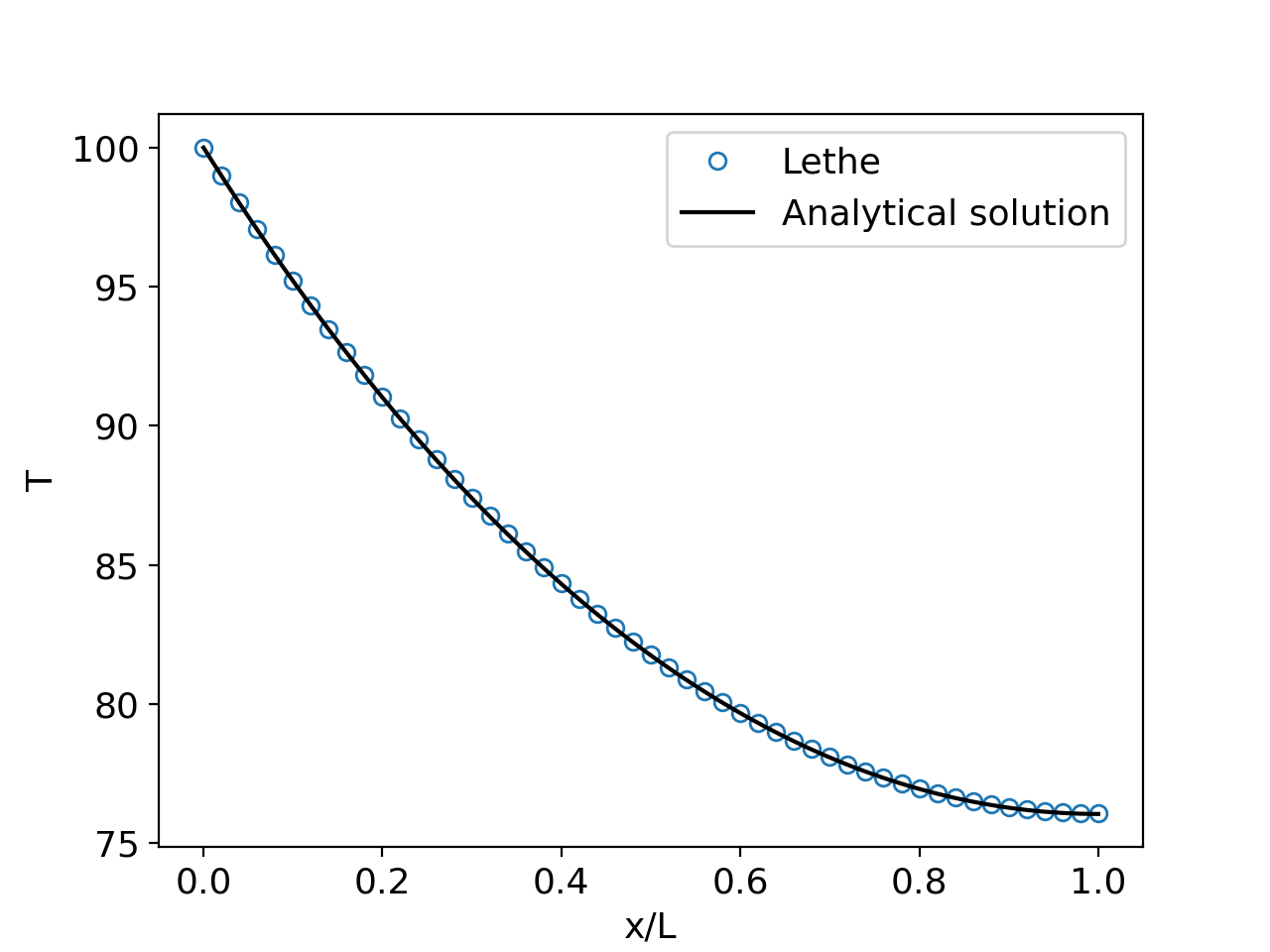Cooling Fin#
This example simulates the heat transfer in a cooling fin, which is a classical problem in heat transfer
Features#
Solver:
lethe-fluidHeat transfer
Usage of a python script for post-processing data
Files Used in This Example#
Both files mentioned below are located in the example’s folder (examples/multiphysics/cooling-fin).
Parameter file:
fin.prmPostprocessing python script:
compare_solution.py
Description of the Case#
A cylindrical fin of length \(L=0.2\) and radius \(R=0.01\) is fixed to a wall at a constant temperature \(T_b=100\). The radial surface of the fin is subject to natural convection following Newton’s law of cooling with \(h=10\) and \(T_{\infty}=20\). The material from which the fin is made has a thermal conductivity \(k=100\mathrm{W/m/K}\). The geometry of this example is illustrated below.
In the case where the Biot number \(\mathrm{Bi}=\frac{hR}{k}<1\), the temperature distribution in the fin can be assumed to vary only along the \(x\) direction and is approximated very adequately by the following equation [1]:
where \(\beta=\sqrt{\frac{hP}{kA}}\) is the fin parameter, \(P\) is the perimeter of the fin, and \(A\) is the cross-sectional area of the fin.
Parameter File#
Simulation Control#
The simulation is done in steady state without mesh adaptation.
subsection simulation control
set method = steady
set output name = out
set output path = ./output/
end
Multiphysics#
The multiphysics subsection is used to to disable fluid dynamics and enable the heat transfer physics.
subsection multiphysics
set fluid dynamics = false
set heat transfer = true
end
Boundary Conditions#
Boundary conditions must be set for both fluid dynamics and heat transfer, even though the former is not used.
Boundary Conditions - Fluid Dynamics#
For the fluid dynamics, we set the boundary conditions to no-slip on all the boundaries.
subsection boundary conditions
set number = 3
subsection bc 0
set id = 0
set type = noslip
end
subsection bc 1
set id = 1
set type = noslip
end
subsection bc 2
set id = 2
set type = noslip
end
end
Boundary Conditions - Heat Transfer#
For the heat transfer, we set the boundary conditions as follows:
subsection boundary conditions heat transfer
set number = 3
subsection bc 0
set id = 0
set type = convection-radiation-flux
subsection h
set Function expression = 10
end
subsection Tinf
set Function expression = 20
end
subsection emissivity
set Function expression = 0
end
subsection heat_flux
set Function expression = 0
end
end
subsection bc 1
set id = 1
set type = temperature
subsection value
set Function expression = 100
end
end
subsection bc 2
set id = 2
set type = convection-radiation-flux
subsection h
set Function expression = 0
end
subsection Tinf
set Function expression = 20
end
subsection emissivity
set Function expression = 0
end
subsection heat_flux
set Function expression = 0
end
end
end
Physical Properties#
In the physical properties subsection, we define the properties of the fin. The thermal conductivity is set to \(k=100\). Even though the fin is technically a solid, by default Lethe calls fluid the material which is used in the simulation domain when there is only one material.
subsection physical properties
set number of fluids = 1
subsection fluid 0
set thermal conductivity = 100
end
end
Mesh#
In the mesh subsection, we define a cylinder with the appropriate dimensions. We use the subdivided_cylinder grid generator to manually control the number of division on the axial direction of the cylinder. The mesh is initially refined \(3\) times to ensure that it is sufficiently fine.
subsection mesh
set type = dealii
set grid type = subdivided_cylinder
set grid arguments = 10 : 0.01 : 0.1
set initial refinement = 3
end
FEM#
We use the FEM subsection to define the order of the finite element method used in the simulation. We set the order to 2 for the temperature field.
subsection FEM
set temperature order = 2
end
Postprocessing#
We calculate the heat fluxes on the boundaries of the fin.
subsection post-processing
set verbosity = verbose
set calculate heat flux = true
end
Running the Simulation#
We can call lethe-fluid by invoking the following command:
Note
This simulation should take less than a minute if Lethe is compiled in release mode
Results#
A postprocessing script is provided with the example. It extracts the axial temperature profile in the fin and compares it with the analytical solution. The script can be run by invoking the following command and specifying the vtu output file:
The following figure shows the temperature distribution in the fin. The analytical solution is also plotted for comparison. The agreement between the simulation and analytical results is excellent.
The postprocessing script also calculates the heat fluxes on the boundaries of the fin. The following table shows the heat fluxes calculated by the simulation and the analytical solution.
Boundary |
Simulation (W) |
Analytical (W) |
|---|---|---|
Radial surface of the fin |
8.019 |
8.020 |
Base of the fin |
8.019 |
8.020 |
We see that even with a relatively coarse mesh, the heat fluxes calculated by the simulation are very close to the analytical solution.
Possibilities for Extension#
The heat flux is sensitive to the finite element order used for the temperature field. Try the simulations again with first-order Q1 elements and compare the results.
